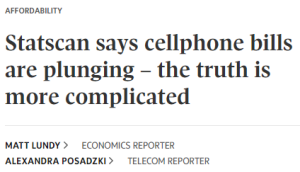Untimely industry monitoring
Yesterday, the CRTC released its annual industry monitoring report for the communications sector. Some of you may be thinking, “two months after year end is pretty good timing.” And it would be heroic timing if indeed the CRTC was reporting on 2023 industry data.
Unfortunately, the report was “Annual highlights of the telecommunications sector 2022” [also available as pdf, 910KB]. That’s right, 2022 data getting released 14 months after year-end.
Among the interesting data in the report is the official tally of Canadian telecommunications industry revenues: $57.2B. As noted by the CRTC, this means that foreign ownership restrictions (under Section 16 of the Telecom Act) only apply to carriers with telecommunications revenues exceeding 10% of that total (ie. $5.7B). In practice, this means Bell, Rogers and TELUS remain the only carriers that must be Canadian owned and controlled.
This was the 23rd edition of the CRTC’s communications industry monitoring reports. Back in the summer of 2000, Cabinet issued Order-in-Council 2000-1053:
Order requiring the CANADIAN RADIO-TELEVISION AND TELECOMMUNICATIONS COMMISSION to report to the Governor in Council, once a year for the next five years, on the status of competition in Canadian telecommunications markets and on the deployment and accessibility of advanced telecommunications infrastructure and services in urban and rural areas in all regions of Canada, and to submit its first report no later than September 28, 2001.

Following the first 5 years that were issued in response to the Cabinet directive, the CRTC continued publishing annual data. I started blogging in 2006 and I have included looks at the reports ever since.
Over time, the annual publication was revised to embed fewer tables, instead accompanying the text with a rich assortment of Open Data downloadable spreadsheets. The CRTC boasts over 400 datasets are available, many of them updated more frequently than once per year. A change log is maintained to help identify updates.
In 2021, the Commission rebranded the statistics as Communications Market Reports. The Market Reports are divided under 5 headings:
These online tables are more current than the annual summary, but there is much room for more timeliness. My records show that 2008 annual data was published in August 2009. The data for 2009 and 2010 were published in July of the subsequent year. Dates started to slide to September 2012 for 2011 data, then November 2017 for 2016 data. And now, the 2022 data took until the very end of February 2024, fourteen months after year-end.
Looking back over nearly a quarter-century of industry monitoring reports, isn’t it reasonable to have expected improvements in delivery over time? Sure, we have more detailed data and open access to some of the data, but collaboration tools should have enabled reporting speeds to improve dramatically.
Notably, as of last week, most public companies have already delivered official financial reports for year-end 2023.
Where do you go for timely telecommunications industry monitoring reports?

